Northern Kyushu Hiking Coast-to-Coast
Dramatic wildlands from Fukuoka to Beppu Hot Springs
Light rain under doleful silence.
Yet smoke still plumes from the mountaintop.
Great Aso by Tatsuji Miyoshi
Comfortably under three hours by bullet train from Osaka or Kyoto or just over an hour by plane, Northern Kyushu is a fantastic gateway to wild nature, grand legends and folktales, together with some of the finest onsen hot springs on the island.
Our self-guided coast to coast Northern Kyushu hiking adventure takes in the best of all of these elements, from four up to ten days, spanning central Fukuoka over to Beppu onsen hot spring in the east, via historically significant Dazaifu, the vibrant Kuju highlands and Japan’s largest active volcano on Mount Aso, with easy extensions to Kumamoto castle town and nature-rich Takachiho in Miyazaki further south.
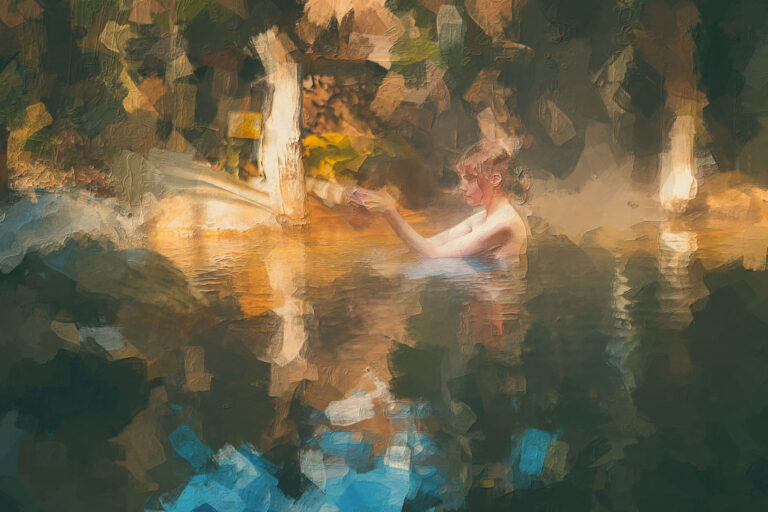
I have all these funny memories of Kyushu.
Fukuoka has a special place in my heart. My first visit more than 15 years ago culminated in a nostalgic street food and music adventure, where I stepped off the train at Hakata station, only to be immediately greeted by a friendly Japanese businessman, who shook my hand with a warm ‘Welcome to Kyushu’.
I have fond memories of the traditional food carts, known in Japan as yatai, where tipsy patrons cram into narrowly curtained off stalls to try a myriad of local favorites, such as oden (boiled stew) or Hakata ramen noodles, which can occasionally descend into drunken karaoke singalongs.
Such yatai are similar to vendors found more commonly on the Asia mainland, but fell out of favour within wider Japan, making Fukuoka a unique start to many a Kyushu trip.
However, Fukuoka is just the tip of the Northern Kyushu iceberg. We ought to talk about the local islets, emotive shrines and temples, awe-inspiring mountainscapes and active volcanoes. Oh, and onsen after onsen after onsen.
After arriving into easy access point Fukuoka, we immediately subvert the image of this bustling metropolis, with a quick nip out to a lovely quiet island to the north, and a leisurely hike with views out to both the city and the sea.
After enjoying some delicious locally caught seafood, we head south and anti-clockwise along our journey with a quick stop at historically significant Dazaifu, which serves as an excellent primer on the history of Kyushu, being the former political center of Kyushu, the site of the Sugawara legend and now the home to the essential Kyushu National Museum, one of only four National Institutes for Cultural Heritage in all of Japan, and the only one built since the 19th century.
We leave Fukuoka to travel deep into the mountains of Kumamoto, affording excellent hiking and an optional side-trip to the city proper with its iconic castle. Kumamoto at its heart is an active volcano and spectacular nature hiking for which we spend ample time with.
Heading east, we head on to equally compelling Oita, with incredible hot springs and its many grand castle towns. After up to five consecutive onsen hot spring stays, with reach the eastern coasts and the fascinating castles towns here. End with a soak in the Beppu onsen hot springs, or head on with easy access back to mainland Japan by train, plane or automobile.
The full ten days in Northern Kyushu is excellent, and the region’s proximity to other local gems means that you easily extend any version of our Northern Kyushu walking tour, with an exploration of the pottery villages of North Western Kyushu, or with a trip to the spiritually and historically rich story and pilgrimage of the Hidden Christians of Hirado and Nagasaki, also on the western coast.
To make your decision even more difficult, Southern Kyushu also has incredible hiking, history and more great onsen hot springs. All five trips intersect neatly with each other, so please inquire if you’re thinking about combining two or more of the itineraries, so that we can provide a suggestion on making the most of your time here to match your interests.
What makes Northern Kyushu hiking worth your time
‣ Dramatic nature hikes of varying lengths, adjustable for all walking levels
‣ Experience some of the best hot springs in all of Japan for up to six stays
‣ Cover a wide variety of culture, featuring all key historic sites in the region
‣ Short journeys between each wonderful hike or sightseeing spot and the inns
‣ Take in the beadth of the area, deeply exploring Fukuoka, Kumoto and Oita regions
‣ History-rich storied temples, shrines and castle towns along the route
Our recommendations
‣ Suggested duration: from five to ten days in total
‣ Distance covered: up to 90km (from 2~16km per day)
‣ Trip level: All levels from beginner through to expert
‣ Hiking: Mountain and hill routes, with some gentle town walks
‣ Hotel style: Traditional B&B, hotels, or alternate between the two
‣ $250 deposit (suggested budget from $1,225~2,150 per person)
Our Northern Kyushu Hiking Model Itinerary
Day 1 – A local side of Fukuoka
Arrive at the gateway to wider Kyushu with bustling Fukuoka, worth an extra night or two in itself, this key Kyushu hub has a vibrant food culture and nightlife, together with world-class museums and sightseeing options. We head north by local train and ferry to a lovely nearby islet for some gentle optional hiking.

Fukuoka is known as the local economic powerhouse, and this lively city has a wealth of options to explore. After we have finished in the city, we take a trip out to explore the area’s softer side, with a gentle but compelling island stroll of up to 11km, a short journey out of the city. Shorter options of three to five kilometers are also enjoyable.
The island affords wonderful coastal views and a deeply spiritual walking course, taking in a local shrine route. Afterwards, we overnight at a nearby coastal inn with great food.
Day 2 – The Legend of Sugawara and a historical political center
Explore Kyushu’s grand political and pirate history, with a gentle walk through the key spiritual and historically significant political hub of Dazaifu.
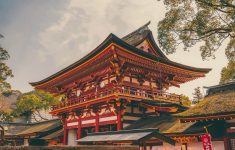
After a traditional breakfast, head south first to an optional local hike at the important spiritual center of Fukuoka, Dazaifu.
First established in the seventh century, Dazaifu has a grand history as the administrative center of all of Kyushu, second only to Kyoto in terms of clout in all of Japan, and a role it occupied for over 500 years.
As a key gateway for cultural exchange between mainland Asia and Japan, we learn about the rise and subsequent decline of Sugawara, the legendary Japanese pirate and self-styled would-be ‘New Emperor’ of Japan active in this region.
We visit key locations here including the main shrine and the compelling National Museum; affording a great primer on the history and wider context of Kyushu island to further enrich the upcoming days on our trip.
Head south by train and overnight in a wonderfully history-rich village situated in southern Fukuoka.
Our main walk today is a gentle two to three kilometers, but with an early morning departure we can also offer an optional local hike of 11km on top.
Day 3 – The Venice of Kyushu and an afternoon of history and nature
After a relaxing stroll around the historic quarter close to your inn, head on by taxi to a wonderful nature and history-rich hike to the east before spending the night at a hot spring (the first of five in a row) nearby.
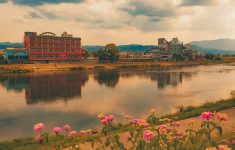
This morning take in an optional scenic cruise through a complex series of canals across the ‘Kyushu town of water’; a low-key but historically significant area of Southern Kyushu, on a flatboat called a Donkobune. The activity is elevated by the gentle scenery and the extent to which the boat keepers maintain the authenticity of the experience, adorning traditional garb and rowing by hand. They may even serenade you with a local folksong or two enroute further adding to the experience.
Not to be upstaged, our hike today is also a spectacular experience; a short drive from your inn takes us to the Southern Fukuoka mountains, and two particularly compelling passes with lovely nature and views, together with significant local temples and shrines, including an impressive three-storied pagoda, a serene Japanese garden and a characteristically varied Jizo statue collection.
With hiking options from four up to 13km, we then stay overnight at a remote hot spring accommodation, situated in a serene parkland. Today’s onsen is the first of up to five consecutive nights, affording a wide variety of mineral baths to explore and compare.
Day 4 – A walk in the park, a walk in the plains
After a short park walk from our accommodation, we enjoy a history and nature themed hike through plains and bamboo forests, and then a historic town and nearby onsen hot spring where we stay tonight.
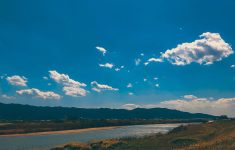
Today, we take in a leisurely morning stroll in the broad parklands around your inn, then a short train ride to a varied hike of 12km involving, in order; a dramatic stone step ascent to our shrine for the day, a nationally recognized bamboo forest and biodiverse plainlands (the walk can also be shortened for those looking for an easier day today).
Later, we take in a carefully preserved traditional town and overnight in a lovely historic Onsen hot spring on our final night in the Fukuoka region.
Day 5 – Fukuoka and Oita onsen, via an iconic mountaintop shrine
A day of historic onsen towns, we take a brief detour into the local mountains for one last excursion in Fukuoka before arriving into Oita.
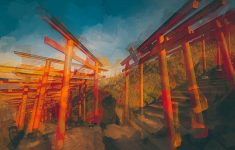
After a morning exploration of the historic town center, we head onwards, but before leaving Fukuoka, we bid farewell in style, with one of Southern Fukuoka’s best loved monuments; an iconic tori gate complex leading to a mountaintop shrine.
After a gentle walk here, depending on the season, there’s an option to add an excursion out to another iconic local site and some remarkable terraced rice fields. We are then transported east and with our first foray into Oita prefecture, with a second night at another excellent onsen hot spring inn.
Day 6 – Open-air hot springs and world-class National Park Hiking
Majestic nature in the Onsen and National Park hiking at the heart of Oita Prefecture.

On our first full day in Oita, we get to explore the full breadth of its majesty; from what is considered to be the definitive open-air onsen hot spring of Kyushu, through to the remarkable Kuju highlands; a registered National Park area and a playground of spectacular hiking.
Our walking options todays take in six up to 12km. Later, we spend a third evening at onsen hot spring; this time one of Oita’s most renowned, with a relaxing bath at just the right time after a long hike.
Day 7 – A a waterfall, a geopark and a live volcano in Kumamoto
Today we visit Mt. Aso, a live volcano and a sublime hiking spot. We take in all its grandeur from afar, before some truly stunning local sights and a top hike. We then overnight, where else, but another excellent onsen hot spring.

Erupting as recently as 2021 and 2016, Aso is a feisty prospect. Although the main crater is frequently closed off due to the volcanic activity, the wider area is a truly enjoyable way to experience the day. We head out after the option to visit other hot springs adjacent to our inn, and take in Aso from one of its most spectacular spots.
Our pre-arranged taxi takes us through some of the volcano’s key areas before allowing us time to take in the mountain range on foot over a seven kilometre walk with a longer option adding a further nine kilometers of hiking.
This evening, now our fifth onsen hot spring is waiting for us at the end of the day.
Day 8 – One last Oita mountain hike and a historic coastal town
Heading east, we get one final lovely hike in the mountains before an overnight stay in an historic castle town on the coast.
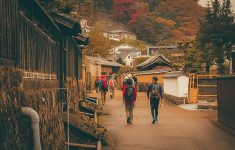
After sneaking in a final soak in our onsen inn this morning, we head out for one last mountain hike of 12 to 16km, a lovely way to end our last full day, before overnighting in an atmospheric castle town on the east coast of Oita.
Day 9 – One final castle town walk before more hot springs
We can enjoy one final gentle castle town walk before heading onwards to our final inn and the steam baths of Beppu Onsen hot springs along the eastern coast.
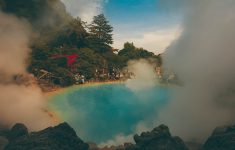
On our last day in northern Kyushu, we end with an optional gentle castle town walk, specifically designed to be easily finished early.
This enables us to head on, either north to Beppu, which is a natural springboard for further onsen or wider Japan adventures, or south, to yet more remarkable hiking and onsen in Takachiho gorge in Miyazaki, and heading further south to Kagoshima and the ancient jungles of Yakushima Island.
Day 10 – Beppu’s hells and deeper into Oita
Time for one last dip and an exporation of Beppu onsen hot spring town before heading onwards.
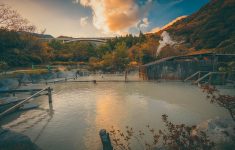
For those with the time to have spent a night in Beppu Onsen hot springs at the end of the trip, we include sightseeing suggestions in the better known Beppu hells, through to some lesser-known hiking nearby.
Things to keep in mind with Northern Kyushu Hiking
We generally avoid city stays, but the inns we book can still fill up in Spring (March to May) and Autumn (September to November), so please inquire and book early. Summer is hot (daytime highs above 30°C) and Kyushu Winters can be a little chilly, although forgivably mild compared with much of Japan, making this a trip very much possible throughout the year.
While not entirely recommended, please let us know if you wish to travel in the June rainy season, or peak holidays such as Golden Week in early May.
This trip is built with walking in mind, which can easily be adjusted. There is enough compelling sightseeing to enjoy an entirely non-walking version of the itinerary for up to six days. Please inquire if you have any questions.
We have aimed to make this trip as easily accessible as possible, typically beginning in Fukuoka and ending in Beppu, both with excellent flight and train links. Please inquire for other locations.
The trip also makes extensive use of the Kyushu train network; many of these trains can be used in conjunction with a nationwide Japan Rail Pass, or the local Kyushu rail pass, so please inquire if you are planning to use the pass.
We recommend a shuttle service on alternate nights, splitting luggage over two bags, or using a daypack on nights in between. Please inquire if you require your luggage on all nights and we can discuss what is possible.
1. How long should I spend in Northern Kyushu?
Five to seven days is a great amount of time in Kyushu for most hikers, but the more mischievious answer is the longer the better (all 10 days of our model itinerary are great fun).
To truly experience the full range of experiences Kyushu has to offer, the longer end of one to two weeks is strongly encouraged, and our Northern Kyushu trip compliments our other Kyushu itineraries; if you are unsure how best to spend your time here, please inquire and tell us how long you have.
2. Is this trip suitable for less confident hikers?
Absolutely. We can modify the schedule for non-walking groups, and would suggest up to six days for purely cultural trips. Please inquire for suggestions.
3. Is Mount Aso safe to walk on?
Every check and effort is made to ensure you will walk on Mount Aso only when it is safe to do so. As a live volcano, it is important to keep in mind that Aso may be inaccessible at certain times, and we appreciate your understanding that we will provide alternative walking activities in such circumstances.
4. Where do we meet you?
All of our trips are self-guided, meaning we do not typically meet our guests face-to-face in person. We will be more than happy to provide an online call to help get you ready for the trip. Please inquire if you would like to request a guide to join the group in Kyushu.
5. I arrive in Kyushu tomorrow, can you help plan my trip?
Please ask, and try to be understanding if we are not able to help. Our suggested booking window is three to six months before traveling to Japan.
6. I am a traveling by myself – will I be okay?
Our trips are perfectly safe for solo hikers. The routes are well-maintained and checked regularly and you always have the phone support of our staff when required.
What we can provide with Northern Kyushu Hiking
‣ 4-9 nights at traditional B&B inns or western-style hotels
‣ All breakfasts (dinners at inns are also recommended)
‣ Personalized schedule book with recommended timetable
‣ Detailed map book for navigation
‣ Orientation book for preparation
‣ Pre-trip and local support
‣ 5 days from JPY180,000 (Approx $1,225)
‣ 6 days from JPY200,000 (Approx $1,410)
‣ 8 days from JPY260,000 (Approx $1,780)
‣ 10 days from JPY310,000 ($2,150)
(per person with twin share)
Hibi Travel was born from a love of local Japan.
We are a small, family-run team, with the aim of connecting visitors with remote communities on immersive, engaging adventures throughout Japan.

